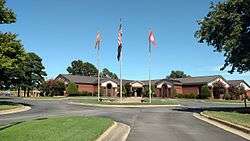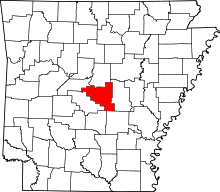Jacksonville, Arkansas
| Jacksonville, Arkansas | ||
|---|---|---|
| City | ||
|
City Hall | ||
| ||
| Motto: "Soaring higher" | ||
 Location of Jacksonville in Arkansas | ||
 Jacksonville, Arkansas Location in the United States | ||
| Coordinates: 34°52′13″N 92°06′55″W / 34.87028°N 92.11528°WCoordinates: 34°52′13″N 92°06′55″W / 34.87028°N 92.11528°W | ||
| Country | United States | |
| State | Arkansas | |
| County | Pulaski | |
| Founded | 1870 | |
| Incorporated | 1941 | |
| Government | ||
| • Mayor | Gary Fletcher | |
| Area | ||
| • City | 28.2 sq mi (73.1 km2) | |
| • Land | 28.1 sq mi (72.8 km2) | |
| • Water | 0.1 sq mi (0.3 km2) | |
| Elevation | 285 ft (87 m) | |
| Population (2010) | ||
| • City | 28,364 | |
| • Density | 1,000/sq mi (390/km2) | |
| • Metro | 729,135 ('14) (Little Rock/North Little Rock) | |
| Time zone | CST (UTC-6) | |
| • Summer (DST) | CDT (UTC-5) | |
| ZIP codes | 72076 | |
| Area code(s) | 501 | |
| FIPS code | 05-34750 | |
| GNIS feature ID | 0057978 | |
| Website | www.cityofjacksonville.net | |
Jacksonville is a city in Pulaski County, Arkansas, United States, and a suburb of Little Rock. As of the 2010 census, the population of the city was 28,364.[1] It is part of the Little Rock–North Little Rock–Conway Metropolitan Statistical Area with 729,135 people as of 2014.
The city is named for Nicholas Jackson, landowner who deeded the land for the railroad right-of-way to the Cairo & Fulton Railroad in 1870. The community evolved from the settlement surrounding the railroad depot, eventually incorporating in 1941. In 1941, construction began on the Arkansas Ordnance Plant (AOP), which served as the primary facility for the development of fuses and detonators for World War II.[2] Following the war, AOP ceased operations and the land was sold for commercial interests, including the development of the Little Rock Air Force Base in 1955. Today, portions of AOP still remain, including the Arkansas Ordnance Plant Guard House, which is on the National Register of Historic Places and the Jacksonville Museum of Military History. Despite Pulaski County being an Arkansas county that is not a "dry" county, as it allows the sales of beer and liquor, the municipal limits of Jacksonville are "moist", as it does not allow the sales of alcohol in stores, but allows the sale of alcohol in some restaurants with special permits.
Geography
Jacksonville is located at 34°52′13″N 92°6′55″W / 34.87028°N 92.11528°W (34.870345, −92.115164).[3]
According to the United States Census Bureau, the city has a total area of 28.2 square miles (73.1 km2), of which 28.1 square miles (72.8 km2) is land and 0.12 square miles (0.3 km2), or 0.42%, is water.[4]
Demographics
| Historical population | |||
|---|---|---|---|
| Census | Pop. | %± | |
| 1950 | 2,474 | — | |
| 1960 | 14,488 | 485.6% | |
| 1970 | 19,832 | 36.9% | |
| 1980 | 27,589 | 39.1% | |
| 1990 | 29,101 | 5.5% | |
| 2000 | 29,916 | 2.8% | |
| 2010 | 28,364 | −5.2% | |
| Est. 2015 | 28,643 | [5] | 1.0% |
As of the census[7] of 2000, there were 29,916 people, 10,890 households, and 8,004 families residing in the city. The population density was 1,134.2 people per square mile (437.9/km²). There were 11,890 housing units at an average density of 450.8 per square mile (174.0/km²). The racial makeup of the city was 64.17% White, 27.88% Black or African American, 0.50% Native American, 1.98% Asian, 0.13% Pacific Islander, 1.14% from other races, and 2.58% from two or more races. 6.24% of the population were Hispanic or Latino of any race.
There were 10,890 households out of which 40.2% had children under the age of 18 living with them, 55.1% were married couples living together, 14.6% had a female householder with no husband present, and 26.5% were non-families. 22.0% of all households were made up of individuals and 5.9% had someone living alone who was 65 years of age or older. The average household size was 2.64 and the average family size was 3.08.
In the city the population was spread out with 29.0% under the age of 18, 12.8% from 18 to 24, 33.2% from 25 to 44, 17.6% from 45 to 64, and 7.3% who were 65 years of age or older. The median age was 30 years. For every 100 females there were 100.4 males. For every 100 females age 18 and over, there were 98.4 males.
The median income for a household in the city was $35,460, and the median income for a family was $40,381. Males had a median income of $26,708 versus $21,804 for females. The per capita income for the city was $16,369. About 11.9% of families and 14.2% of the population were below the poverty line, including 20.5% of those under age 18 and 7.9% of those age 65 or over.
Climate
The climate in this area is characterized by hot, humid summers and generally mild to cool winters. According to the Köppen Climate Classification system, Jacksonville has a humid subtropical climate, abbreviated "Cfa" on climate maps.[8]
Education
Since 1927, Jacksonville had been part of the Pulaski County Special School District, one of the largest school districts in Arkansas. In the years leading up to September, 2008, parts of the Jacksonville community expressed a desire to split from the PCSSD. This measure was approved by the board of the PCSSD during that month, clearing the way, legally, for the formation of what would become Jacksonville North Pulaski School District.
In a response to a petition signed by more than 2,000 voters, the Arkansas Board of Education ordered an election to carve a new school district out of the existing Pulaski County Special School District.[9] Jacksonville voters approved of the separation on September 16, 2014 with a vote of 3,672 for and 202 against (95% to 5%).[10]
According to JNPSD officials, the district would be administered by the Pulaski County Special School District until its final detachment, which became effective July 1, 2016.[11]
The district consists of seven elementary schools, one middle school and one high school.[11] The schools include Jacksonville High School, Jacksonville Middle School, Bayou Meto Elementary School, Arnold Drive Elementary School, Tolleson Elementary School, Dupree Elementary School, Pinewood Elementary School and Taylor Elementary School.
A number of privately operated daycare services and church-affiliated schools are also available throughout the city. In addition, Arkansas State University-Beebe maintains a degree center at Little Rock Air Force Base for post-secondary education.
Public libraries

The Central Arkansas Library System includes the Esther Dewitt Nixon Library in Jacksonville.
Notable people
- Homer Martin Adkins, governor of Arkansas from 1941 to 1945, was born in Jacksonville in 1890.
- Kris Allen, American Idol Season 8 winner
- Lisa Blount, actress, memorable role An Officer and a Gentleman
- Clinton McDonald, Defensive tackle for the Tampa Bay Buccaneers. Former defensive tackle for the Seattle Seahawks of the NFL, Super Bowl XLVIII champion; played college football at Memphis
- Dan Hampton, Daniel Oliver Hampton also known as "Danimal" (born September 19, 1957) is a retired Hall of Fame American football defensive tackle who played twelve seasons for the Chicago Bears from 1979 to 1990 in the National Football League. He was elected to the Pro Football Hall of Fame in 2002. Previously hosted pre- and post-game shows for the Bears on WGN Radio in Chicago.
- Bob Johnson, Democratic member of the Arkansas House of Representatives from Jacksonville since 2015; former Pulaski County justice of the peace[12][13]
- Robert Thomas, Robert Lee Thomas, IV (born December 1, 1974) is a former American football fullback in the National Football League. Thomas played college football at Henderson State University and would go on to play fullback for the Dallas Cowboys, as the lead blocker for Emmitt Smith.[14]
- Demetrius Harris, current Tight End for the Kansas City Chiefs. Collegiate basketball player with the Milwaukee Panthers.
References
- ↑ "Profile of General Population and Housing Characteristics: 2010 Demographic Profile Data (DP-1): Jacksonville city, Arkansas". U.S. Census Bureau, American Factfinder. Archived from the original on September 11, 2013. Retrieved December 1, 2011.
- ↑ "World War II Ordnance Plants". Encyclopedia of Arkansas. Retrieved December 10, 2010.
- ↑ "US Gazetteer files: 2010, 2000, and 1990". United States Census Bureau. 2011-02-12. Retrieved 2011-04-23.
- ↑ "Geographic Identifiers: 2010 Demographic Profile Data (G001): Jacksonville city, Arkansas". U.S. Census Bureau, American Factfinder. Archived from the original on September 11, 2013. Retrieved December 1, 2011.
- ↑ "Annual Estimates of the Resident Population for Incorporated Places: April 1, 2010 to July 1, 2015". Retrieved July 2, 2016.
- ↑ "Census of Population and Housing". Census.gov. Archived from the original on May 11, 2015. Retrieved June 4, 2015.
- ↑ "American FactFinder". United States Census Bureau. Archived from the original on September 11, 2013. Retrieved 2008-01-31.
- ↑ Climate Summary for Jacksonville, Arkansas
- ↑ Thornton, Stephen (7 September 2014). "Jacksonville-area vote on school district a 1st". Arkansas Democrat-Gazette. Retrieved 20 October 2015.
- ↑ "Unofficial Results Show Favor for Starting Jacksonville School District". KARK. 16 September 2014. Retrieved 20 October 2015.
- 1 2 "About Us". Jacksonville North Pulaski School District. Retrieved 20 October 2015.
- ↑ "District 42". ballotpedia.org. Retrieved April 14, 2015.
- ↑ Max Brantley (September 6, 2013). "Republican JP Bob Johnson switches parties to run for state House as Democrat". The Arkansas Times. Retrieved April 15, 2015.
- ↑ Robert Thomas (fullback)
External links
- City of Jacksonville official website
- Jacksonville Chamber of Commerce
- The Leader, Jacksonville, northern Pulaski County's and Lonoke County's largest local newspaper
- The Jacksonville Patriot, a weekly newspaper published on Wednesdays


